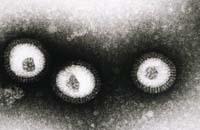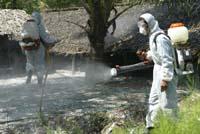Resurrects the deadly 1918 virus
2005/10/30 Galarraga Aiestaran, Ana - Elhuyar Zientzia

Photo: R. Hamilton/who
The intention to decode the virus genome and redo it has not been, at all, to kill mice. The goal is very different. In fact, researchers hope to be able to make vaccines and medicines against avian influenza that today threatens us.
In fact, avian flu not only contaminates birds, but also people and leads them to death. Health authorities are taking drastic measures to prevent the spread of the virus, as otherwise there is a risk of spreading the pest to everyone. But there is no effective treatment or prevention against this virus, which is new to humans.
Scientists believe something similar happened in 1918. Then, the ‘Spanish flu’ killed 20-40 million people worldwide. Some say the dead were 50 million. The truth is that this virus caused a terrible killing and, like today, the mutation of a typical bird virus resulted in a virus capable of killing people.
That is why the 1918 virus is so interesting to scientists. Once investigated, they hope to find the way to curb the current one. At least they have that hope. A key gene for that virus has already been identified, which if removed is not capable of causing death. Blocking three other genes prevents the proliferation of the virus. It should be noted that the virus contains only eight genes, while the human being is estimated at around 30-40 thousand.
Resuscitating viruses

To resuscitate the virus they have departed from the samples of a friend who died in 1918. The corpse has been preserved for many years in the Alaska Permafrado, and in the 1990s the traces of its lung samples and decoding the virus genome began to be analyzed. To do this, they have recovered RNA from lung tissue, converted it into DNA and sequenced it.
The entire sequence has now been published and, from this information, the DNA of the virus has been synthesized in another laboratory. Subsequently, this DNA has been introduced into human renal cells, thus obtaining virus particles. They have isolated and injected them into the mouse.
In the laboratory, the virus has shown that it has not lost some of its ability to cause death. Five days later, all the mice had died. If the virus enters the lung cells, in four days it generates 39,000 times more viruses than a conventional influenza virus.
Risk

Researchers hope that the experiment will help combat avian influenza. (FAO/H.D.Nam)
However, many researchers do not see the experiment with good eyes. They find it a huge danger. On the one hand, there is a risk of virus leakage, as is the case of the SARS virus that fled three laboratories in 2003-2004. And on the other hand, the virus genome has been put in the database, from where anyone can acquire it and regenerate it. However, scientists supporting the research have responded that the greatest danger lies in nature.
Published in 7K.




